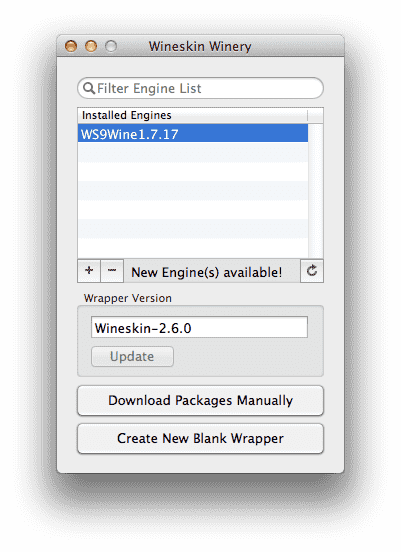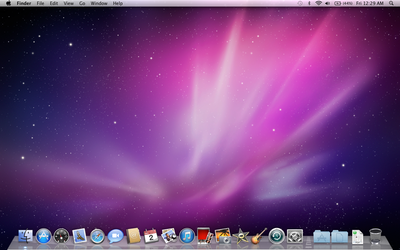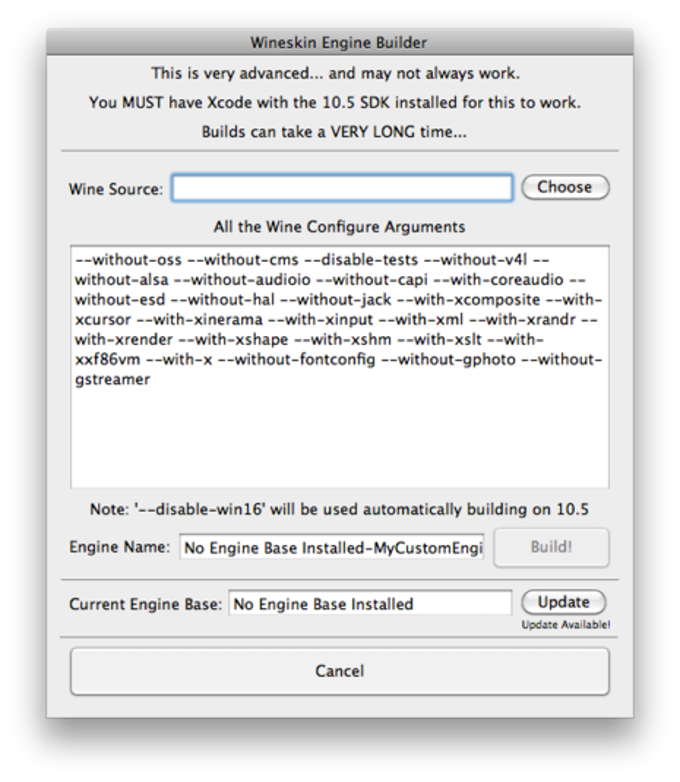
If you want to run Wavosaur audio editor on MAC OS X, it’s now possible : with Wineskin, one can do a wrapper that handle a Windows software into a Mac app.
And we have done it for you !
Download Wavosaur 1.1.0.0 for MAC OS X
Wineskin runs on the following MAC devices; 1. OS X 10.6 Snow Leopard 2. Wineskin 2.6.0 Released! Wine versions from around 1.5.26+ have a Wine Mac driver that can also be used instead of needing X11. Wineskin 2.6.0 Release Candidate 1! 21, 2014) Urge Software LLC donates this website, as well as development, to Wineskin. Any Donations made by anyone for Wineskin will only be used for Wineskin, and nothing else. Factory SEALED MAC OS X 10.6.3 Snow Leopard Install New Version MC573Z/A. Mac OS X Snow Leopard Upgrade DVD. If you need help, please look through forum postings related to running Wine on MacOSX Snow Leopard or review this on the MacPorts web site. But it failed at the end because wine 1.x did not support snow leopard. But what's wrong with the devel build?
=> Wavosaur for MAC OS X <=


It has been tested and works for :

- OS X 10.6 Snow Leopard
- OS X 10.8 Mountain Lion
VST plugins are working : just be sure to use the Windows dll version (not the Mac version)
Download the ready-to-use Mac app or follow this guide for building a Wavosaur application for MAC :
How to build a Mac app from the Wavosaur windows executable with Wineskin
Wineskin is a free tool able to build a MAC port for Windows application : http://wineskin.urgesoftware.com.
The ports come as normal Mac application bundle.
Wineskin is based of course on Wine.
Here’s a step by step guide, you need an internet connexion and a MAC computer :
1) download Wineskin Winery
2) download Wavosaur 32 bit and extract Wavosaur.exe on your HD
3) download MFC42.dll
4) unzip and launch Wineskin Winery app
Wineskin Winery app
Wineskin Mac Os Catalina
If there are no packages / wrappers, just use the “update” button and “+” button to add engine from the Web. You may need to restart the app to make the engine appears in the list.
5) click “Create New Blank Wrapper”
Enter the name for the Mac program : “Wavosaur” is a good choice !
6) if you get some windows asking you for installing .NET support or Gecko support, just click “cancel”, Wavosaur doesn’t need .NET framework in order to run. It just needs a dll file, we’ll add it on step 10)
not .net
7) After some time, you should get the window as seen below :
click “View wrapper in Finder”
then close the Wineskin Winery App
How To Use Wineskin Mac
8) right click on Wavosaur.app and select “Show Package Contents”, you should see a folder, a shortcut and a Wineskin.app
Wavosaur on Maaac !
9) open drive_c /ProgramFiles and copy Wavosaur.exe into it
10) open drive_c /Windows/System32 and copy MFC42.dll into it
11) launch Wineskin.app, and select “Advanded”
12) click on “browse” for the Window EXE and select Wavosaur.exe from the “drive_c/Program Files”. You can also set an icon if you want => Wavosaur Mac icon
Set Wavosaur
At this time you can Test Run : it works ! If not, you can see an error log.
Wineskin Mac Snow Leopard Rose
13) close the Wineskin.app, now you can use Wavosaur.app by double clicking on it, like any Mac application.
Copy Wavosaur.app anywhere you want (/Applications sounds like a good place).
Wine Mac Os X Leopard
How To Install:
A few notes:
**Important** The most recent version of the “old” LMMS that works with Wineskin is 0.4.10. Everything from that up to the recent betas and 1.0.0 either crashes or the audio doesn’t work correctly. And, while the “new” versions of LMMS work, there are some audio artifacts/glitches during playback. 0.4.10 does not seem to have these issues. However, it may be the Wrapper and/or Engine version of Wineskin rather than the LMMS version that is the issue. Experiment with different versions if you can’t get it working at first. When I first installed LMMS, I started with the latest version at the time (0.4.13) and worked my way backwards until I found a version that would work. I can confirm that the 32-bit 0.4.10 version of LMMS runs near-perfectly with Wineskin Wrapper 2.5.9 and Engine WS9Wine1.5.27 on Mac OS X version 10.6.8.** I can also confirm that LMMS 1.0.0 runs just as good, save for the aforementioned audio artifacts/glitches with Wineskin Wrapper 2.6.0 and Engine WS9Wine1.7.17, also on OS X 10.6.8. I haven’t tested any other versions of OS X, so I can’t say whether it will work on them or not. It might, I just don’t know cause I haven’t tried it.
Only 32-bit programs work with Wine, so make sure to download the 32-bit version of LMMS.
This guide assumes you have Wineskin already installed. If you don’t, you can download it at http://wineskin.urgesoftware.com/.
Yes, I know you can install it via Macports. However, every time I tried that, I couldn’t get the audio working. Also, until recently the latest version available was 0.4.4 (or maybe it was 0.4.8—point is, it was old).
1. Open ‘Wineskin Winery’ and download the latest wrapper and engine(s).
2. Create a New Blank Wrapper using that engine and title it “LMMS.” It will ask if you want to install Mono and Gecko. I do not believe that LMMS needs these programs, but I’m not 100% sure.
3. Whether you install them or not, when Wineskin finishes doing its thing go to the Wrapper in the Finder (~/Applications/Wineskin/LMMS.app). Drag your newly installed LMMS.app to your “Applications” folder. Right click the app and select “Show Package Contents.”
4. In the folder that opens, there will be a “Wineskin” application. Open it and click “Install Software” and then, “Choose Setup Executable.” In the window that pops up, locate your LMMS .exe and open it.
5. Follow the LMMS setup wizard like you normally would if installing on Windows. When it is finished installing, a window will appear asking you to choose the startup executable. Choose LMMS.exe from the drop down menu.
6. Back in LMMS’s internal Wineskin application, open the Advanced Settings and change the version number from “My Program Version” to the version of LMMS that was installed. Also, associate the .mmpz file extension with LMMS if you want (this lets you open LMMS project files from the Finder).
7. In order to set up the app’s icon, go to /Applications/LMMS.app/Contents/Resources/drive_c/Program Files/LMMS/data/themes/default/icon.png and open it in Preview. Save it as a .ICNS file (with alpha enabled) in a different folder—say, the desktop—and then return to the internal LMMS Wineskin app. Back in Advanced Settings, click “Browse” under where it says “Icon” and select your icon.ICNS file. For older versions with low quality icons, follow the above instructions, but use /Applications/LMMS.app/Contents/Resources/drive_c/Program Files/LMMS/data/themes/default/splash.png
8. Start LMMS. The LMMS Setup window should appear. Under “Paths,” you may want to change the LMMS Working Directory to a custom LMMS folder in your user “Music” folder (LMMS/Wine should see the path as Z:/Users/[Username]/Music/LMMS), so that you can easily reinstall or upgrade without having to dig through your LMMS Wrapper to find your projects, samples, and presets. Just point it to the directory again after upgrading to a new version. Under “Audio settings,” select “PortAudio” as the Audio Interface, then select “Windows DirectSound” as the Backend and “Built-in Output” as the Device.
9. Now that you’re done setup, close LMMS so that the settings changes take effect and reopen it. You should be able to use LMMS just like you would on a Windows machine, though certain parts might not work correctly, like VSTs, which are specifically for Windows. It might be possible for you to get them working, but it would probably take a lot of effort.
**Apparently, I upgraded the Wrapper and Engine since first installing LMMS 0.4.10, so I can also confirm that Wineskin 2.5.5 & Wine Engine WS9 1.5.6 work as well, though probably not as smoothly as the newer versions.
I'm gonna test 1.0.0 some more and update this if I find out what's causing the audio glitches. I'm also gonna try updating my 0.4.10 install to the latest Wrappers and Engines.